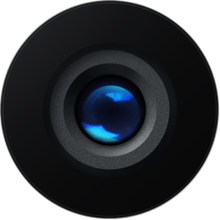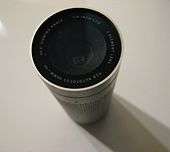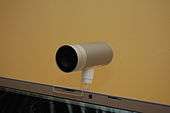iSight
 | |
| Overview | |
|---|---|
| Maker | Apple Inc. |
| Type | Motion picture camera |
| Lens | |
| Lens | Glass, internal auto-focus lens system |
| F-numbers | 2.8 |
| Sensor/Medium | |
| Image sensor type | Digital CCD |
| Image sensor size | 1/4-inch; 640×480 resolution |
| Recording medium | Attached to computer via FireWire |
| Focusing | |
| Focus | Automatic (50 mm – ∞) |
| Shutter | |
| Shutter speeds | Continuous up to 30 frame/s |
iSight is a brand name used by Apple Inc. to refer to cameras on various devices. The name was originally used for the external iSight webcam, which retailed for US$149, connected to a computer via a FireWire cable, and came with a set of mounts to place it atop any then current Apple display, laptop computer, all-in-one desktop computer, or flat surface.
Apple introduced iSight at the 2003 Worldwide Developers Conference, It was intended to be used with iChat AV, Apple's video-conferencing client. iMovie (version 4 and later) could also be used to capture video from the device. In April 2005, Apple released a firmware update for the iSight to improve audio performance. As of October 13, 2008, the external iSight was no longer for sale in the Apple online store or in retail locations.
Meanwhile, Apple began using the term to refer to the camera built into Apple's iMac, MacBook, MacBook Air, and MacBook Pro computers, Thunderbolt Display, and Cinema Display. In November 2010, Apple began calling them "FaceTime cameras". However, the term was not retired, as the third-generation iPad, fourth generation iPad, iPad Air, iPad Air 2, iPad Pro, iPad Mini, iPad Mini 2, iPad Mini 3, iPad Mini 4, the fifth-generation iPod Touch, the sixth-generation iPod Touch, the iPhone 7, the iPhone 6S, the iPhone 6, the iPhone SE, the iPhone 5S, the iPhone 5C, iPhone 5, the iPhone 4S, and the iPhone 4 all incorporate an “iSight” rear camera in addition to a front-facing “FaceTime” or “FaceTime HD” camera.
Design

The external iSight's ¼-inch color CCD sensor has 640×480-pixel VGA resolution, with a custom-designed three-part F/2.8 lens with two aspherical elements. It features autoexposure, autofocusing from 50 mm to infinity, and video capture at 30 frames per second in 24-bit color with a variety of shutter speeds. However, the iSight has an image delay of approximately 120 ms.
The iSight incorporates internal microphones with dual-element noise suppression. The actual camera only takes up one-quarter of the unit; the remaining space is primarily occupied by its two microphones and mounting socket.
The iSight camera weighs 2.3 ounces (63.8 grams). It uses a single FireWire 400 (IEEE 1394a) cable (included) for audio, video and power.

Four camera mounts, a plastic tube carrying case and a FireWire camera mount adapter are also included. The user can select the mounting bracket most appropriate for their monitor or other mounting surface. It is fully compatible with its native Mac OS X, as well as partially compatible with the Microsoft Windows and Linux operating systems.
The iSight has a small green LED that illuminates when the camera is in use. It also has an iris that closes by twisting the front of the camera.
Built-in iSight

Although external and internal iSights have significant differences, Apple has used the "iSight" name to brand its built-in video camera found in their MacBook (Includes Redesigned MacBook), MacBook Air and MacBook Pro notebook computers, iMac desktop computers produced since late 2005 and the LED Cinema Display. While the external iSight is similar to the built-in iSight, the built-in iSight uses an internal USB 2.0 interface and not the FireWire 400 (IEEE 1394a) interface used by the external iSight camera.[1] Further, the built-in iSight has a plastic lens, is fixed-focus, and uses a CMOS active pixel sensor, rather than the CCD used in the external iSight. With the LED-Backlit MacBook Pros, Apple has moved to using a sensor capable of 1280x1024 pixels. The built-in iSight can also be used in the Photo Booth application on OS X and iOS. The FaceTime cameras included with the 2011 versions of the MacBook Pro and iMac can output high-definition video. A panorama feature is also incorporated on the iPhone 4S,[2] iPhone 5,[3] iPhone 5S, iPhone 5C, iPhone 6, and iPhone 6 Plus,[4] along with the iPod Touch (5th generation).[5]
Security concerns
Some MacBooks are affected by the iSeeYou vulnerability, potentially allowing their iSight cameras to record the user without the user's knowledge.[6][7]
iSight on Linux
Linux kernel 3.0+ internally contains the driver for the iSight camera.[8]
For previous versions of the kernel, one has to manually take out the firmware from Apple's driver through a specific program. This is because the Apple driver cannot be deployed inside a Linux distribution, the cause being legal issues.[9] This lack of native support in the kernel for iSight persists on MacBook 2,1.[10]
iSight vs. FaceTime
The June 2010 release of the iPhone 4, where Apple introduced the FaceTime communication platform, also involved them naming the integrated front-facing camera on the device to be called a "FaceTime Camera". Subsequent devices released, including later iOS products and all OS X devices following from the October 2010 release of the new MacBook Air (which like previous models, still feature a front-facing webcam integrated into their screens), also had the camera on them similarly named.
However, with the release of the third generation iPad in March 2012, while Apple continued to name the front facing camera as the "FaceTime Camera" on all iOS devices, they also re-introduced the name "iSight Camera" for the rear camera on all iOS devices (retroactively, in the cases of the iPhone 4 & 4S) and on the 5th generation of iPod Touch, the new 5MP camera, introduced as an iSight camera.
In general usage, this rear camera is used to take higher-resolution images, whereas the front-facing camera is used for lower-resolution face-to-face conversations with other users using the FaceTime communication platform.
References
- ↑ Apple Developer Connection, "15-inch MacBook Pro Developer Note" Archived October 10, 2008, at the Wayback Machine., Last updated: May 9, 2006.
- ↑ "Apple - iPhone - iPhone 4s Technical Specifications". Apple Inc. Retrieved 1 October 2014.
- ↑ "iPhone 5 - Technical Specifications". Apple Inc. Retrieved 1 October 2014.
- ↑ "Apple - iPhone - Compare Models". Apple Inc. Retrieved 1 October 2014.
- ↑ "Apple - iPod touch - Technical Specifications". Apple Inc. Retrieved 1 October 2014.
- ↑ https://www.washingtonpost.com/news/the-switch/wp/2013/12/18/research-shows-how-macbook-webcams-can-spy-on-their-users-without-warning/
- ↑ http://techland.time.com/2013/12/20/apple-please-give-us-a-fix-a-guarantee-that-our-isight-webcams-are-safe/
- ↑ Linux 3.0 - Linux Kernel Newbies
- ↑ https://help.ubuntu.com/community/MactelSupportTeam/AppleiSight?action=show&redirect=AppleiSight
- ↑ "MacBook 2,1". h-node.org. Retrieved April 25, 2015.
External links
| Wikimedia Commons has media related to iSight. |
- iSight Linux audio driver project page
- iSight Linux driver project on SourceForge
- iSight Programming Guide for FireWire iSight cameras on Apple.com
